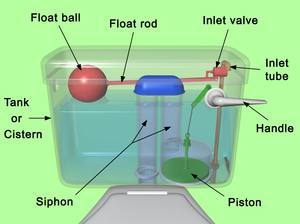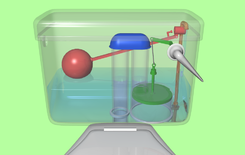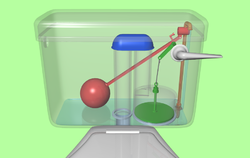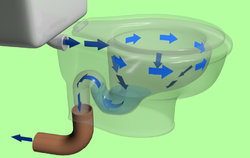This post by Roberts Plumbing, Inc. is to help you understand the parts of a common flush toilet and how it works! A flush toilet disposes of our waste products by using water to send these products through a drainpipe to another location. The picture below shows a typical toilet. The toilet bowl usually has a ring-shaped seat on top, which is covered by the lid when not in use. The handle/button, is pressed to flush the toilet. The water used for flushing is stored in the tank (also called a cistern).
Main parts of a toilet:
The tank contains some important parts. The next picture shows the parts of a typical tank. The inlet valve controls the water supply coming into the tank. It lets water in when the tank is empty and stops water coming in when the tank is full.
The “float ball” rises as the tank fills with water. As it rises, the float rod attached to it presses against the inlet valve. When the tank is full, the rod is pressing against the inlet valve hard enough to turn the water off. This stops the tank from overflowing.

Parts of a typical Toilet Tank:
When you press the handle, a lever inside the tank pulls the piston up, forcing some water through the siphon. This provides suction in the siphon, and the rest of the water within the siphon ‘U’ tube follows. The piston is usually covered by a plastic membrane, which is constructed to be “sucked” out of the way by the emptying siphon tube water, allowing the rest of the water in the tank to rush past the piston, and over the top of the siphon, emptying the rest of the tank. The piston membrane then drops back onto the piston, ready for the next flush operation.

A Toilet Tank emptying:
The tank empties quite quickly, and the float ball floats to the bottom. That means the float rod is no longer pressing against the valve, so water begins to flow into the tank, filling it up again.

A Toilet Tank empty:
The water which left the tank goes through a short pipe to the toilet bowl. It sloshes around the rim, down the sides of the bowl, and out through the drainpipe, cleaning the bowl and carrying the waste with it. Arrows showing the way water flows from the cistern, through the toilet bowl, and out.
Some of the clean water coming behind remains at the bottom of the toilet bowl. That’s because modern toilets have a ‘S’ bend which remains filled with water between flushing. The water in the ‘S’ bend stops bad odors escaping from the drainpipe. During flushing the ‘S’ bend also provides siphon action which helps speed up the flushing process.
However, since this type of toilet does not generally handle waste on site, it would be connected to a separate waste treatment system such as a septic system or public sewer.




